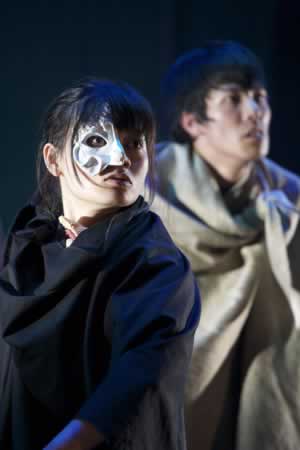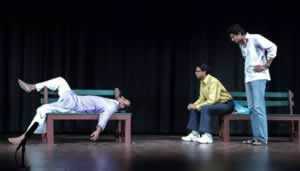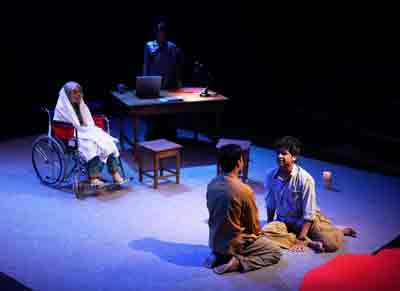Gambhira-Gambhira by Parimal Tribedi
The Play
The play tells the story of Bhubhan, a Gambhira artist. Bhubhan believes that without truth, Gambhira is not possible. What we see today, Bhuvan says, is not the original Gambhira. It’s only a mike, a mike to announce various projects like sanitation, literacy, health etc. It has lost its voice. The vandana that they once sang to please lord Shiva is now sung to please the political leaders. The voice which once spoke against the social follies and foibles, now advertises different projects.
Director’s Note
I was born and brought up in a village. In those days there was no television. Radio was the possession of only rich people. So we found our sources of entertainment only in Jatra, Alkap, Manosa Gan, Kirtan, Gambhira and other forms of folk theatre. Among these ‘Gambhira’ was the most powerful medium to depict the follies of the society of the time. It spoke the truth. It spoke for the common people. But now, days have changed. Entertainment has several fountainheads and in the crowd of media and hordes of TV channels the true ‘Gambhira’ is lost. I miss it. I miss its real flavor, its power to speak the truth.
As ‘Gambhira’ has its own distinct identity and it bears the folk identity of Malda district, it was difficult to give it a dramatic shape. I have gone through a lot of experiments and studies. Its language, tone, song, dance, body movement, costume, and theme – every part of it needed an in-depth attention. It was not an easy task to string all the parts into a single thread. We have to arrange workshops, seminar and several sessions of talks with the Gambhira artists to bring clarity on each part of Gambhira. The play took about eight months to get prepared. In these eight months we tasted the real flavor of Gambhira and earned a great experience.
The Director & Playwright
Director, actor, playwright and founder of ‘Malda Malancha’, Parimal Tribedi is a well-known theatre personality in Bengali Theatre and is a Member of Paschimbanga Natya Akademy. For the last twenty one years he has been leading his present group ‘Malda Malancha’ in the mofussil district, Malda. In these years he has directed nearly fifty plays. He has written 15 plays which has been staged and highly acclaimed.
Some of the noted plays written by Parimal Tribedi are Gambhira Gambhira, Ranir Ghater Brittanto, Bhalo Manush, Ratan, Udas Puja, Asamayer Bhabna, Lotun Jevan, Swasti and Lajja. He has directed almost all these with his group.
The Group
A group of young but competent theatre workers led by Sri Parimal Tribedi formed ‘Malda Malancha’ in 1993 to devote itself to the task of promoting the glorious tradition of experimental theatre movement. “Malancha” ventured to produce some significant modern plays, both original as well as in translations. “Malda Malancha” also organises theatre festivals every year and conducts seminars and theatre workshops.



